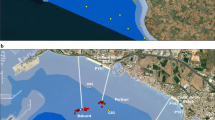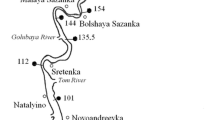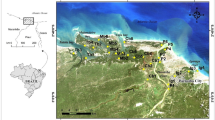Abstract.
The study of the geochemical composition of 52 samples of surface sediments from the Tinto and Odiel river estuary shows high concentration rates of Fe (11.21%), Cu (928 ppm), Zn (1,146 ppm), Pb (730 ppm) and Ba (660 ppm). High concentrations of metals are caused by the river contribution of sediments from areas with a high mining activity and from the industrial activity carried out on the estuary banks. Estuary sediments are divided into four groups: group 1, formed by low polluted siliciclastic gravel and sand; group 2 of highly polluted muddy sediments of river origin; group 3, formed by sandy muds of mixed origin with an average pollution rate; and group 4, formed by muddy sediments from the system's inner zones with an intermediate-high pollution rate. In all the cases the coefficients of metallic enrichment are high (superiors at 9), except for the Fe, indicating a high capacity of dispersion of the load metallic pollutant.
Similar content being viewed by others
Author information
Authors and Affiliations
Additional information
Electronic Publication
Rights and permissions
About this article
Cite this article
Borrego, .J., Morales, .J., de la Torre, .M. et al. Geochemical characteristics of heavy metal pollution in surface sediments of the Tinto and Odiel river estuary (southwestern Spain). Env Geol 41, 785–796 (2002). https://doi.org/10.1007/s00254-001-0445-3
Received:
Accepted:
Issue Date:
DOI: https://doi.org/10.1007/s00254-001-0445-3




